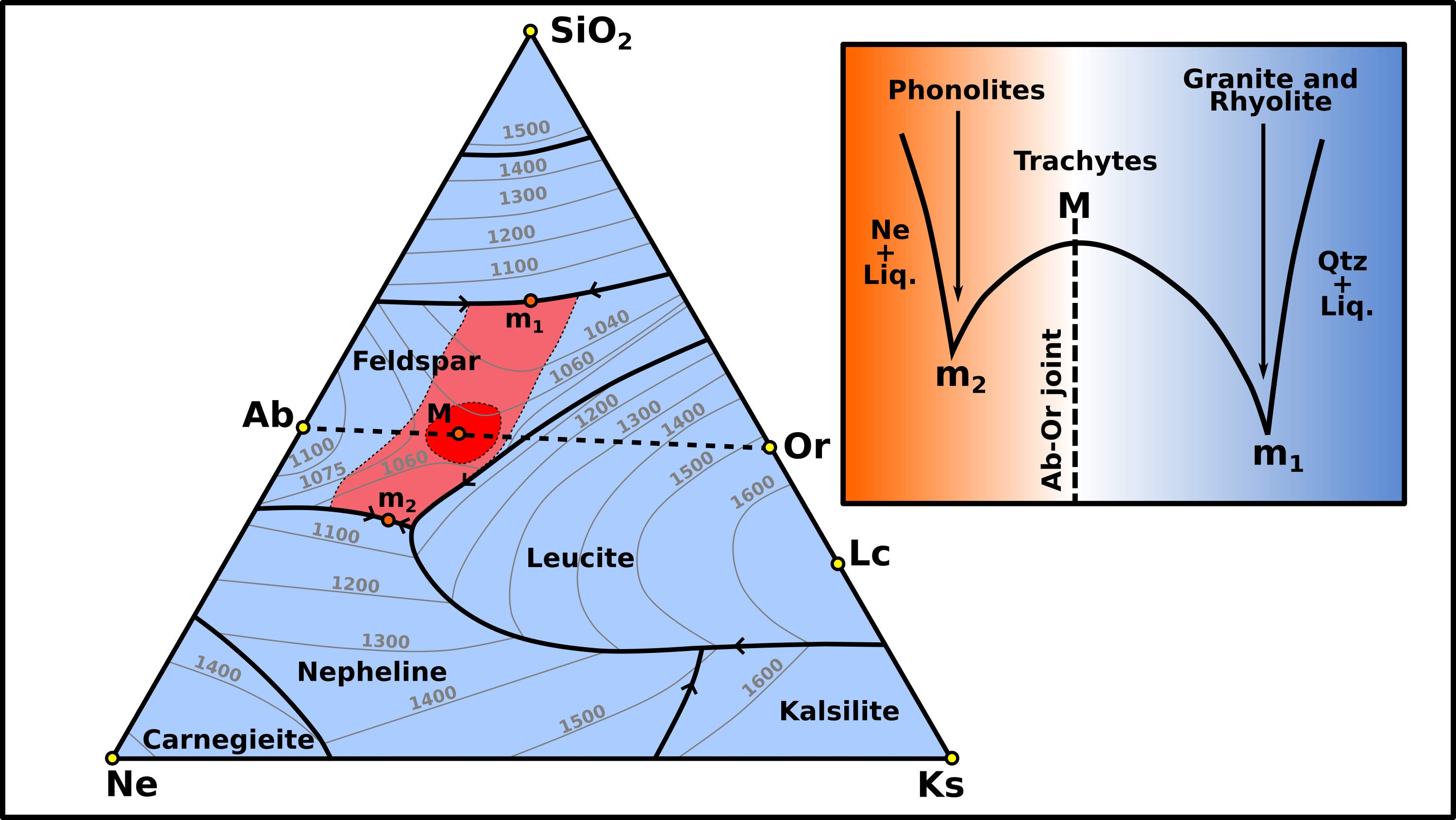Trachyte
Trachyte is a fine-grained and generally light-colored volcanic rock that usually has a rough surface to the touch which is the reason it was given that name (trachys is "rough" in the Greek).Trachytes are composed chiefly of alkali feldspar with minor amounts of dark-coloured minerals such as biotite, amphibole, or pyroxene. Compositionally, trachyte is the volcanic equivalent of the plutonic (intrusive) rock syenite. Most trachytes show porphyritic texture in which abundant, large, well-formed crystals (phenocrysts) of early generation are embedded in a very fine-grained matrix (groundmass). The phenocrysts are usually sanidine, and may range up to two to five centimetres (one to two inches) across; smaller phenocrysts of other minerals may also occur. Rapid cooling and solidification of trachytic lava produces the fine texture of the groundmass, and cooling may be so rapid locally that small quantities of glass are formed. Trachyte is commonly associated with other lavas in volcanic regions and is thought to have been formed by the crystallization and abstraction of iron, magnesium, and calcium minerals from a parent basaltic lava.
Two types of trachyte are commonly recognized. In potash, or normal trachyte, sanidine or orthoclase is the dominant feldspar, and the plagioclase feldspar is generally oligoclase. In soda, or alkali, trachyte, both the alkali feldspar and the dark minerals are rich in sodium. As the ratio of alkali feldspar to plagioclase decreases, trachyte passes into latite. Normal trachytes may contain diopside; alkali types may show pyroxene crystals with diopsidic cores. Silica-rich trachyte may have small amounts of quartz that is interstitial to feldspar; tridymite and cristobalite are commonly found lining the small cavities that developed as expanding gas bubbles in the molten lava. As the free silica content increases, trachyte passes into rhyolite. Marked decrease in silica favours the formation of such feldspathoids as leucite, nepheline, sodalite, and analcime; as the quantity of feldspathoids increases, trachyte passes into phonolite.
Trachytes and the Petrogeny’s Residua System
Trachytes appear to occupy a paradoxical position within the ternary system NaAlSiO4 (nepheline)-KalSiO4 (kalsilite)-SiO2 (quartz) which bowen has called Petrogeny’s Residua System (Fig.1). This system contains two temperature minima (m1 and m2 separated by a thermal divide M). One of these minima corresponds to silica-saturated granitic or rhyolite compositions (m1), whereas the other corresponds to silica undersaturated phonolite or the intrusive equivalent, nepheline syenite (m2). On cooling, the composition of many of the common residual magmas end up in this system, and fractional crystallization drives them toward the low-temperature trough, or termal valley (point m1-M-m2).
Fig.1: Petrogeny’s Residua System: Cg = Carnegieite, Ne = Nepheline, Ks = Alkali Feldspar, Lc = Leucite, Ab = Albite, Or = Orthose. m1-M-m2 = low-temperature trough (pale red), M = central ridge of the low-temperature trough (red). The small diagram to the right of the Petrogeny’s Residua System, represent a termal section (like geological section but, in place of isolines, we have isotherms) along the line m1-M-m2. Note the morphology of the termal valley with the two subsidiary troughs and the central ridge.
In detail this low-temperature trough is found to contain a central ridge (M) that split the trough into two subsidiary troughs (m1 and m2 minima). One minor trough contains liquids of rhyolite-granite composition (m1), whereas the other contains liquid of phonolite-nepheline syenite composition (m2). In this simplified system, trachytic liquids occupy a composition field that is situated on the thermal ridge (M) between the rhyolitic and phonolitic minima. Thus the evolution of trachytic liquids pose the problem of how can a liquid remain critically saturated with regards to silica during fractional crystallization, and finally congeal on a thermal ridge, and not move towards either silica oversaturation (the rhyolites) or silica undersaturation (the phonolites).
It has been postulated that the shape of the low-temperature trough in Petrogeny’s residua system may change at higher pressures and/or at higher partial pressure of water vapour. Experimental studies have, however, shown that under hydrous conditions the general shape of the low-temperature trough is modified, but the rhyolite-granite and phonolite-nepheline syenite subsidiary troughs are preserved at pressures up to 1.0 GPa. Such increase in pressure do, however, contract the field occupied by leucite, and this helps to explain why leucite is not normally found in plutonic rocks.
.jpg)
Porphyritic trachyte from Gran Canaria. From Sand atlas.
.jpg)
Sanidine phenocryst within a trachyte, Drachenfels, Germany. From Nuno Correia.
Bibliography
• Cox et al. (1979): The Interpretation of Igneous Rocks, George Allen and Unwin, London.
• Howie, R. A., Zussman, J., & Deer, W. (1992). An introduction to the rock-forming minerals (p. 696). Longman.
• Le Maitre, R. W., Streckeisen, A., Zanettin, B., Le Bas, M. J., Bonin, B., Bateman, P., & Lameyre, J. (2002). Igneous rocks. A classification and glossary of terms, 2. Cambridge University Press.
• Middlemost, E. A. (1986). Magmas and magmatic rocks: an introduction to igneous petrology.
• Shelley, D. (1993). Igneous and metamorphic rocks under the microscope: classification, textures, microstructures and mineral preferred-orientations.
• Vernon, R. H. & Clarke, G. L. (2008): Principles of Metamorphic Petrology. Cambridge University Press.


(1).jpg)
(2).jpg)
(3).jpg)
(4).jpg)
(5).jpg)
(6).jpg)
(7).jpg)
(8).jpg)
(9).jpg)
(11).jpg)
(12).jpg)
(13).jpg)
(15).jpg)
(16).jpg)
(17).jpg)
(18).jpg)
(19).jpg)
(20).jpg)

.jpg)
.jpg)
.jpg)
.jpg)
.jpg)
.jpg)
.jpg)
.jpg)
.jpg)
.jpg)
.jpg)
.jpg)
.jpg)
.jpg)
.jpg)
.jpg)
.jpg)
.jpg)
.jpg)